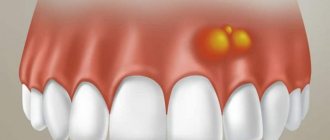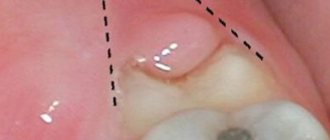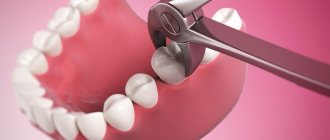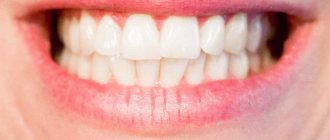- When is it necessary to remove the lower wisdom tooth?
- Tooth eruption problems. Wisdom teeth removal in advance
- Indications and contraindications
- Preparation for the procedure
- Removal steps
- Possible complications after removal
- Time and prices for the procedure
- Advantages of treatment at Aurora
Removal of a wisdom tooth on the lower jaw
Most people of conscious age go to the dentist because of problems with their lower wisdom teeth.
They often interfere, put pressure on neighboring molars, and cause discomfort or pain after eating. Most often, wisdom teeth in the lower jaw appear between the ages of 20 and 25, although the timing varies from person to person; for some, they may appear at the age of 16, for others closer to 40 years. In most cases, the appearance of figure eights is accompanied by various complications that require their removal. Malocclusion, difficulty in teething, tumors and trauma to the mucous membrane and much more.
What to do?
First, contact the administrator of the medical organization (chief physician, deputy chief physician, head of department) with a request to explain the reason for the refusal or request for payment. In most cases, the problem is resolved on the spot. If the administrator refuses to help, contact your medical insurance company (name, phone number, address, email address is on your compulsory medical insurance policy). Insurance company employees will provide you with the necessary advice and, if necessary, take measures to solve the problem.
Types of dental care
When is it necessary to remove the lower wisdom tooth?
Eighth teeth are removed in two cases: when they have not yet sprouted or are already protruding from the gums. In the first case, the operation is performed if the patient feels discomfort, and during an external examination the doctor does not see diseased teeth. The appearance of pain means that the molar in the gum is pressing on its neighbor and disturbing him.
If the wisdom tooth has erupted incorrectly - that is, not straight up, but with a deviation, at an angle to the jaw and neighboring teeth, then removal is also a mandatory procedure. The slope of the figure eight is:
- distal - when the “eight” is tilted back, away from the “seven”. In this case, there is a risk of injury to the gums and damage to the roots of the adjacent tooth;
- medial - when the “eight”, on the contrary, is inclined towards the neighboring tooth. This increases the likelihood of damage to the crown part of the “seven” and the development of caries on both teeth;
- buccal – in this case, the wisdom tooth is turned towards the cheek and constantly touches the mucous membrane, causing irritation and hardening of the tissues. This condition can eventually lead to the formation of a tumor on the mucosa.
The removal of a wisdom tooth in the lower jaw is definitely necessary in the following cases:
- Caries on a wisdom tooth.
- Lack of space in the row for teeth. The last molars put pressure and cause discomfort.
- Pain in the gum where the wisdom tooth is located, at any time of the day, even after sleep.
- Incorrect growth sideways towards the tongue or larynx. This phenomenon is called dystopia.
- It interferes with implantation.
A tooth can erupt without causing pain once it appears; it will still be removed because it is not growing properly. The dentist makes an accurate diagnosis. To make an appointment, leave a request on the website or call one of the numbers: +7-924-444-05-45 - administrator
Removing a wisdom tooth in the lower jaw is a more complex procedure than removing an upper tooth. The bottom eights have a more powerful root system, and the jaw bones are denser and thicker. To remove a lower molar, it is necessary to perform a complex operation with dissection of the gum. In some cases, the surgeon has to remove part of the bone, divide the root into several parts and extract them separately.
Sign up for a free consultation
Should I delete everything at once or one at a time?
Simultaneous removal of all “eighth” teeth at once has a number of pronounced advantages over “multiple” ones. Let's compare! For clarity, we will combine all the pros and cons in a table.
| One by one | All wisdom teeth at once |
| Efficiency When any tooth is removed, the neighboring and antagonist tooth begins to move. We delete one at a time - the displacement occurs 4 times. Increased risk of loose teeth, gum recession, and bone damage | Efficiency Movement in the dentition occurs simultaneously and is quickly “compensated”, i.e. stops and does not progress. Your orthodontist will tell you “Thank you!” |
| Medicines Antibiotics will have to be taken after each removal; this is not obvious at first glance, a very serious obstacle | Medicines Medicines are taken only once, which is especially convenient in the presence of concomitant diseases |
| Stress Obviously, four visits to the doctor, especially for the purpose of removal, are four reasons for unnecessary worries | Stress The operation is performed “in your sleep” under sedation - there is no fear, no pain, no unpleasant memories |
| Time management Call the clinic administrator 4 times and adapt to the surgeon’s schedule, spend 6-8 hours in traffic jams, plus 4-10 hours in the chair | Time management Choose a convenient time only once, go to bed, go home after 3-4 hours, having rested and slept |
| Safety In the “tooth by tooth” format, the temptation to remove it where it is cheaper is sometimes too great. Most complications are the result of removal at the “Anywhere” clinic | Safety Such operations can only be carried out in maxillofacial surgery with a very high level of equipment, qualifications and responsibility. There is absolutely no threat to your life and health here. |
Ordinary dental clinics recommend removing wisdom teeth one at a time due to insufficient equipment , starting with the anesthesiology department, ending with the sterility of the instruments and the operating units themselves, and the unconvincing qualifications of the doctors.
The topic of wisdom teeth removal is shrouded in a dense veil of fears, doubts and concerns that small private clinics willingly support.
Tooth eruption problems. Wisdom tooth removal in advance
Many patients think that if the wisdom tooth is not visible on the gum, then there is no need to worry. However, over time, this molar increases in size and begins to interfere with the others. Waiting until the wisdom molar appears can lead to the following problems:
- pain in the tooth and gum;
- caries between molars;
- curvature of the roots of a healthy chewing tooth;
- infection in the place where the molar erupts because it grows incorrectly;
- curvature of the bite.
It is easier for a doctor to pick up and remove a tooth that has not yet come out. So while there is no pain, it is better to have surgery in advance.
Indications and contraindications
The attending physician (therapist) or orthodontist directs the removal of a molar in the lower jaw. In any case, the patient is sent for a panoramic photo, where the location of the teeth is visible. This procedure facilitates the work of the surgeon who has to deal with a complex operation. Contraindications for removal are as follows:
- Pregnancy and breastfeeding. After such a complex removal, the mother will have to stop breastfeeding, because antibiotics and painkillers can get into the baby along with the milk.
- People of the older generation with a diseased heart, hypertension of the 2nd or 3rd degree should be attentive to their health and not rush into surgery, but it is better to refuse it altogether.
- Malignant formation in the tooth growth zone.
Tooth extraction is also done as a preventive measure in advance, so that later they do not hurt and do not interfere with others.
Diagnostics using a computed tomograph with ENT mode
Accurate diagnosis before extraction is a necessary condition for eliminating complications. The Center uses a Sirona Galileos dental tomograph (Germany).
- an accurate picture of the location of teeth, canals and roots
- ENT mode with the ability to diagnose sinuses
- using a 3D image of the jaw during surgery
The choice of a doctor to remove teeth, especially complex ones, should be taken extremely seriously. Average surgeons usually do not stand on ceremony during the procedure. The result of an operation carried out in a hurry, without proper preparation and adherence to gentle removal measures - bone structures of the jaw broken in pieces, wandering remains of roots, unremoved cysts growing into the maxillary sinus, perforations, fistulas, osteomyelitis and much more. Not to mention the shocking post-operative pain that overtakes the patient after such punitive surgery. Entrust removal to an oral and maxillofacial surgeon. Only the maxillofacial surgeon has enough theoretical and practical skills to perform tooth extraction without complications.
Preparation for the procedure
Before removing a tooth, it is necessary to undergo a computed tomogram (CT ). The device allows you to illuminate the teeth and see the location of the crowns and roots in the gums. CT will make the surgeon’s work easier and save him from a long and complex operation. The procedure is painless. Done quickly.
The choice of tooth extraction technique depends on several factors:
- the presence or absence of inflammation of the soft tissues surrounding the tooth,
- duration of the process,
- location of the third molar in the bone,
- contacting a doctor during periods of exacerbation or remission of the disease,
- degree of tooth crown destruction.
Removal steps
The procedure can be divided into three stages:
- preparatory;
- The operation itself;
- After surgery.
Preparatory stage.
At this stage, the doctor visually examines the patient's oral cavity. Then a computed tomography is done to look at the length and shape of the roots, the depth of the tooth, etc.
Surgery
Complex wisdom tooth removal is divided into several stages. Let's consider a generalized operation scheme:
- A painkiller is given. To do this, a needle is inserted into the lower jaw to the nerve bundle so that the patient does not feel pain. Lips, chin, tongue are numbed. If sensitivity does not disappear, an additional injection is given. After anesthesia, the course of a complex extraction procedure depends on the location of the tooth.
- An incision is made with a scalpel.
- The tooth is sawed down to make it easier to remove.
- Take out the crown and roots.
- The wound is treated and sutured.
This completes the surgical stage.
Postoperative stage
This stage is very important, its duration is 7 – 10 days. During this period, the surgical wound heals, and a clot first forms in the hole and then resolves. Patients must follow our doctor's instructions exactly to avoid post-operative complications.
Tooth extraction: how long does the procedure take?
With a simple type of extraction, the procedure is carried out in 10 - 20 minutes. The process of complex removal lasts from 30 minutes or longer, depending on the specifics of the operation. For example, removing a horizontal tooth can take up to 2 hours or more. At the same time, sometimes additional preparatory procedures are necessary, which also take time.
After tooth extraction in the lower jaw antibiotics to prevent the entry and spread of infection. Such complex manipulations are contraindicated for pregnant and nursing mothers. Painkillers are prescribed to reduce pain after the procedure.
For complex removal, the patient is asked to come back again in five days or earlier if a fever appears. If the tooth has come out halfway (semi-retinated tooth), removal is carried out in the same way, but it is easier to pull it out, since part of the molar is on the surface.
Terms of assistance
It should be remembered that in accordance with the Territorial Program, when applying for dental care, emergency medical care must be provided immediately; provision of emergency primary health care is no more than 2 hours from the moment of application.
The waiting period for an appointment with local doctors should not exceed 24 hours from the moment the patient contacts the medical organization.
The time frame for consultations with medical specialists when providing primary specialized health care in a planned manner is no more than 14 working days (in Moscow 10 calendar days) from the date the patient contacts the medical organization.
The timing of diagnostic instrumental (radiographic studies, ultrasound studies) and laboratory tests in the provision of primary health care should not exceed 14 working days (in Moscow 10 calendar days) from the date of appointment.
The timing of computed tomography (including single photon emission computed tomography), magnetic resonance imaging and angiography in primary health care should not exceed 14 working days from the date of appointment.
Possible complications after removal
Complications after surgery arise due to violations of doctors’ recommendations. Patients begin to rinse their mouth, go to the bathhouse, play sports, or do not take medications that were prescribed. It is absolutely IMPOSSIBLE to do this for 5 days, because the place where the tooth was located is easily inflamed. Pain after removal is normal. Because the anesthesia wears off and the gums heal. Taking painkillers reduces pain.
Without taking antibiotics, inflammation and suppuration may begin. This situation arises due to the fact that food often accumulates at the end of the gums, which is difficult to remove with a brush, and along with it remain microbes that cause suppuration.
If bleeding occurs after removal, you should press the wound with a cotton pad for 15 minutes. If the bleeding does not stop, you should consult a doctor.
For reference! For high-quality and rapid healing, it is necessary that the wound heals well, so you should not eat hard food for at least 5 days and clean the hole.
Time and prices for the procedure
This complex operation takes about an hour. The duration of the procedure depends on the complexity of the figure eight position and the degree of neglect.
The consultation is free of charge. The final cost can be found out after consulting a specialist.
| Name of service | Unit | Price |
| Primary appointment (examination, consultation) with a dental surgeon | units | 0 |
| Repeated appointment (examination, consultation) with a dental surgeon | units | 500 |
| Complex tooth extraction with root separation | units | 7000 |
| Removal of periodontitis tooth | units | 2000 |
| Removal of a permanent tooth | units | 4000 |
| Flap surgery in the oral cavity in the area of the 1st tooth | units | 2000 |
| Flap surgery in the oral cavity on periodontal tissues (convet flap displacement) | units | 6000 |
| Removing stitches | units | 200 |
| Suturing the oral mucosa | units | 500 |
| The operation of removing an impacted, dystopic or supernumerary tooth | units | 8000 |
| Stopping alveolar bleeding without suturing using hemostatic materials | units | 500 |
A detailed price list can be found on the website.
Make an appointment for lower wisdom tooth removal
Byshlyaga Dmitry Yurievich
Byshlyaga Dmitry Yurievich Orthopedic dentist
Extensive practical experience. Regularly undergoes internships and advanced training courses.
Working hours: from 9.00 to 20.00, daily, seven days a week, by appointment
Make an appointment
More details
Asatryan Alexander Aramovich
Asatryan Alexander Aramovich Dentist therapist - orthopedist - surgeon
Extensive practical experience. Regularly undergoes internships and advanced training courses.
Working hours: from 9.00 to 20.00, daily, seven days a week, by appointment
Make an appointment
More details
×
Advantages of treatment at Aurora
Removing the lower wisdom tooth is a complex procedure that requires high specialist competence. Due to the inconvenient location and improper growth of the last molar, neighboring teeth suffer. Highly qualified specialists of our center easily and quickly carry out complex operations of this level. In addition, Aurora dentistry has other important advantages over its competitors:
- the possibility of receiving installments from Pochtabank or Renaissance Credit;
- individual approach;
- work on weekends, including for residents of the region by appointment;
- The doctor is assisted by an assistant, which allows him to carry out manipulations 2 times faster;
- modern, 100% high quality, imported materials.
Our dentistry offers the following promotions for the removal of the lower wisdom tooth:
- If you found out about us through 2GIS, we provide 5% on services;
- 10% discount on your birthday and the next 3 days
- For pensioners there is a “Golden Watch” promotion - a 10% discount on tooth extraction from 9-00 to 11-00
If you need complex and long-term dental treatment in Blagoveshchensk, we have an individual discount policy and a flexible payment schedule
To make an appointment, just call. On the appointed day, the doctor will see the patient and tell him how the lower wisdom tooth will be removed without pain after the procedure and fear.
What dental care is not included in the Territorial Program?
Dental prosthetics is excluded from the program; this type of dental care is paid for from the personal funds of citizens, except for the privileged category of the population, which is financed from the corresponding budget. Unfortunately, there are cases of illegal denial of free dental care under the Territorial Program or you are offered to pay for the specified care.
The insurance company often receives a question: is it possible to install a photopolymer filling under a compulsory medical insurance policy? The fact is that each region has its own Territorial State Guarantee Program, which includes a different range of medical services. In most regions, this type of filling is not included in the list. If there is such a possibility, then the choice of filling material is carried out exclusively by the dentist, with the obligatory informing of the patient about the treatment method.
In Moscow, photopolymer material is not included in the list of services under the compulsory medical insurance policy. Types of filling material: cement, metal-containing filling, filling made of chemically cured composite material.
For more detailed information, you can check with your insurance representative at the contact center number 8-800-200-92-04.











